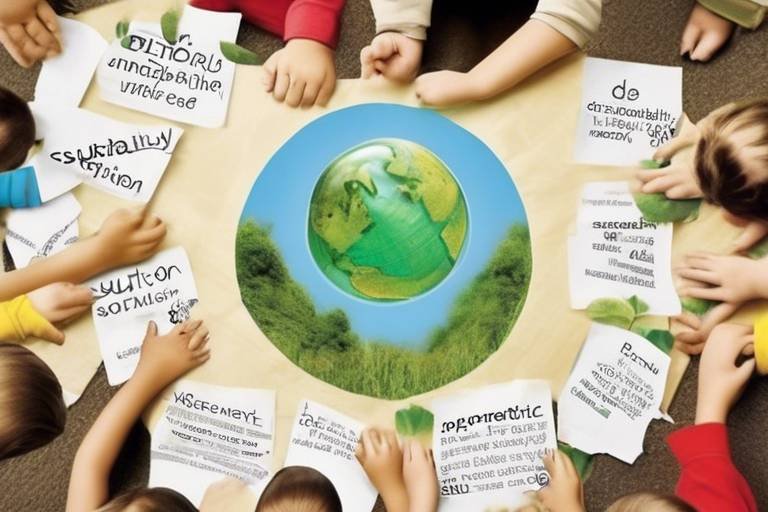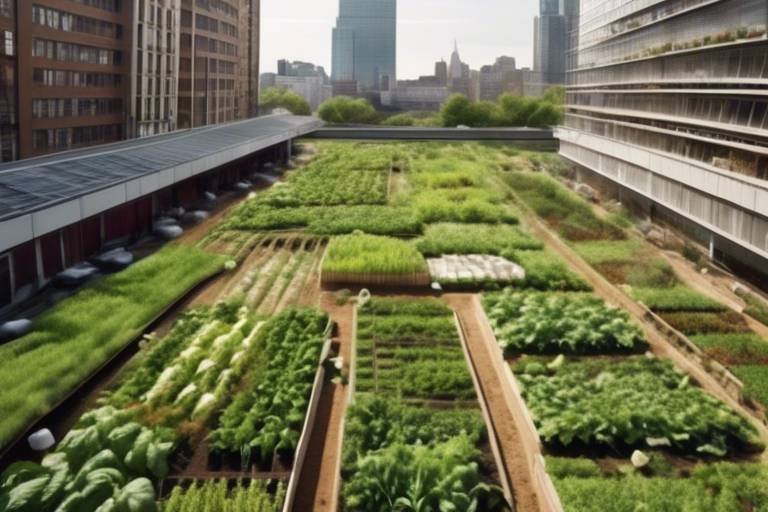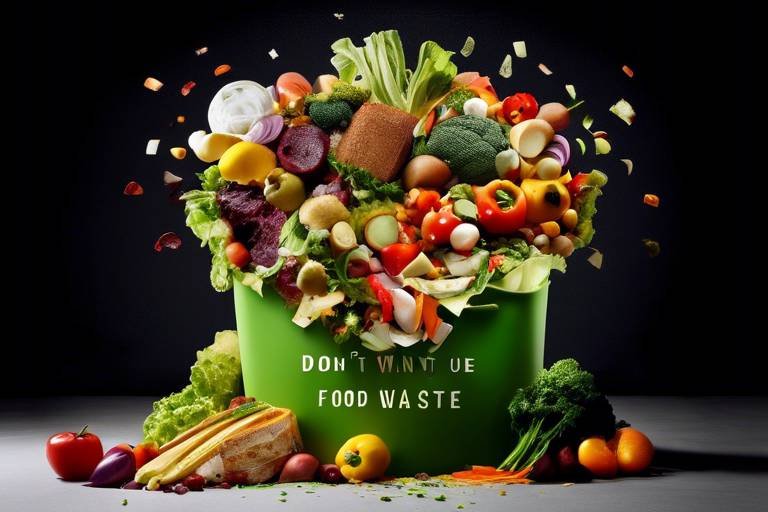Importance of Sustainability in Education
Sustainability in education is not just a trend; it’s a necessity. As we navigate through the 21st century, the challenges posed by climate change, resource depletion, and social inequities are becoming increasingly evident. The role of education in addressing these challenges cannot be overstated. By integrating sustainability into educational frameworks, we are not only preparing students for the future but also equipping them with the tools they need to become responsible global citizens. Imagine a world where every student graduates with a deep understanding of environmental stewardship and social responsibility. Isn’t that a future worth striving for?
When we talk about sustainability in education, we’re referring to a holistic approach that encompasses environmental, social, and economic dimensions. It's about teaching students how their actions can have profound impacts on the world around them. This approach fosters a mindset that values long-term thinking over short-term gains, encouraging students to consider the broader implications of their choices. For instance, when students learn about renewable energy sources, they're not just memorizing facts; they're understanding the importance of reducing carbon footprints and preserving natural resources. This kind of education is essential for nurturing informed citizens who can tackle complex global issues with confidence.
Moreover, sustainable education promotes critical thinking and problem-solving skills. It challenges students to ask questions like, “How can we reduce waste in our school?” or “What are the social implications of our consumption habits?” These questions lead to rich discussions and innovative solutions, preparing students to confront real-world challenges head-on. The benefits extend beyond the classroom, as students carry these lessons into their communities, inspiring others to adopt sustainable practices.
Incorporating sustainability into education also has the potential to enhance student engagement. When students see the relevance of what they’re learning to their own lives and the world around them, they become more invested in their education. For example, a school that implements a recycling program or a community garden not only teaches students about sustainability but also invites them to actively participate in these initiatives. This hands-on approach fosters a sense of ownership and responsibility, which is crucial for personal growth and development.
As we look ahead, the importance of sustainability in education will only continue to grow. The world is changing rapidly, and our educational systems must adapt to prepare students for the complexities of tomorrow. By prioritizing sustainability, we can cultivate a generation of leaders who are equipped to create positive change in their communities and beyond. So, let’s embrace this challenge and work together to make sustainability a cornerstone of education for all.
- What is sustainability in education?
Sustainability in education refers to the integration of environmental, social, and economic principles into teaching and learning processes. - Why is sustainability important for students?
It prepares students for future challenges, fosters critical thinking, and encourages responsible citizenship. - How can schools implement sustainability practices?
Schools can start by incorporating sustainability topics into the curriculum, establishing recycling programs, and engaging students in community projects. - What are some examples of sustainable education practices?
Examples include project-based learning, community partnerships, and hands-on learning opportunities like school gardens.

Understanding Sustainability in Education
Sustainability in education is more than just a buzzword; it's a vital framework that integrates environmental, social, and economic principles into the learning process. But what does this really mean for our students and the future of our planet? At its core, sustainability in education emphasizes the importance of teaching students not only about the world around them but also how to engage with it responsibly and thoughtfully. It's about preparing them to tackle the pressing challenges of our time, from climate change to social inequality.
To understand sustainability in education, we should first consider its key components:
- Environmental Awareness: Teaching students about ecosystems, biodiversity, and the impact of human activity on the planet.
- Social Responsibility: Encouraging students to understand their role in society and the importance of equity and justice.
- Economic Viability: Instilling knowledge about sustainable practices that can lead to economic growth without depleting natural resources.
These components work together to create a holistic approach to education that empowers students to think critically about their choices and their consequences. Imagine a classroom where students are not just passive recipients of information but active participants in their learning journey. They engage in discussions about renewable energy, analyze case studies on sustainable agriculture, and even participate in local conservation efforts. This kind of education fosters a sense of ownership and responsibility, equipping students with the tools they need to make a difference.
Moreover, integrating sustainability into the curriculum is essential for fostering a generation that is not only knowledgeable but also passionate about making positive changes. It's about creating a culture of sustainability that extends beyond the classroom walls and into the community. When students learn about sustainability, they are more likely to carry these values into their personal lives, influencing their families and peers. This ripple effect can lead to significant changes in how communities approach environmental stewardship and social responsibility.
Incorporating sustainability in education is not just beneficial for students; it also prepares them for the realities of a rapidly changing world. As they learn to navigate complex global challenges, they develop critical thinking skills that are invaluable in any career path they choose. Whether they become scientists, educators, or activists, the principles of sustainability will guide their decisions and actions.
In summary, understanding sustainability in education is about recognizing its multifaceted nature and the profound impact it can have on students and society. By embracing this approach, we can cultivate a generation that is informed, engaged, and ready to lead the charge towards a more sustainable future.

Benefits of Sustainable Education
Sustainable education is not just a buzzword; it’s a transformative approach that enriches the learning experience and prepares students for a rapidly changing world. Imagine a classroom where students are not only absorbing information but also actively engaging with their environment and community. This is the heart of sustainable education! By weaving sustainability into the fabric of learning, we can cultivate critical thinking, promote responsible citizenship, and arm students with the skills they need to thrive in an uncertain future.
One of the most significant advantages of sustainable education is its ability to foster critical thinking. When students are exposed to real-world problems related to sustainability, they learn to analyze situations, weigh options, and develop solutions. For instance, consider a project where students assess their school’s energy consumption and propose ways to reduce it. This not only teaches them about energy efficiency but also encourages them to think critically about their choices and their impact on the environment.
Moreover, sustainable education promotes responsible citizenship. Students learn that their actions have consequences, not just for themselves but for the community and the planet. This awareness cultivates a sense of responsibility and encourages students to become advocates for change. They start to understand the importance of participating in community initiatives, such as local clean-up days or tree-planting events, which in turn fosters a sense of belonging and purpose.
Another incredible benefit is the preparation of students for a changing world. As environmental issues become more pressing, the demand for knowledgeable individuals who can navigate these challenges will only increase. Sustainable education equips students with the necessary skills to tackle these problems head-on. They learn about renewable energy, waste reduction, and sustainable agriculture, which are all crucial topics in today’s job market.
To illustrate the benefits, let’s take a look at a few key areas where sustainable education makes a significant impact:
| Key Areas | Benefits |
|---|---|
| Critical Thinking | Encourages analysis and problem-solving skills. |
| Responsible Citizenship | Promotes community involvement and environmental stewardship. |
| Career Preparedness | Equips students with relevant skills for future job markets. |
In addition to these core benefits, sustainable education also encourages hands-on learning opportunities. When students engage in projects that require them to apply sustainability concepts, they gain practical experience that deepens their understanding. For example, working on a community garden project allows students to learn about ecosystems, nutrition, and teamwork, all while getting their hands dirty! This experiential learning not only makes education more enjoyable but also reinforces the importance of sustainability in everyday life.
Furthermore, sustainable education cultivates leadership skills. As students advocate for environmental issues, they learn how to communicate effectively, work collaboratively, and lead initiatives. These skills are invaluable, not just in their academic careers but in their future personal and professional lives. Whether they are leading a school project or participating in community discussions, they are equipped to make a difference.
In conclusion, the benefits of sustainable education are vast and multifaceted. It empowers students, enriches their learning experiences, and prepares them for a future where sustainability is paramount. As we continue to face global challenges, integrating sustainability into education will be essential in shaping informed, responsible, and proactive citizens.
- What is sustainable education? Sustainable education integrates ecological, social, and economic principles into teaching and learning to foster a more responsible and engaged citizenry.
- How does sustainable education benefit students? It enhances critical thinking, promotes responsible citizenship, and prepares students for future challenges, among other benefits.
- What are some examples of sustainable education practices? Examples include project-based learning, community involvement, and curriculum integration strategies that focus on sustainability.
- What challenges exist in implementing sustainable education? Challenges include resource limitations, resistance to change, and varying levels of awareness among educators and institutions.

Empowering Students
Empowering students through sustainable education is like giving them a superpower—one that not only enhances their learning but also equips them to tackle real-world challenges. When students engage in sustainability initiatives, they take on roles that encourage initiative and leadership. It's not just about learning facts and figures; it's about transforming knowledge into action. Imagine a classroom where students are not merely passive recipients of information but active participants in shaping their environment and community. This shift in mindset is crucial for fostering a generation that is not only aware of environmental issues but is also motivated to make a difference.
Active participation in sustainability projects cultivates a sense of ownership among students. They become stewards of their environment, learning to care for the planet and their communities. For instance, when students participate in a community garden project, they don’t just learn about plant biology; they also understand the importance of local food systems, biodiversity, and the impact of agriculture on climate change. This hands-on experience connects them to their lessons in a profound way, making learning both relevant and impactful.
Moreover, the empowerment of students through sustainability education extends beyond the classroom. It encourages them to develop critical thinking skills as they analyze environmental issues and explore potential solutions. By engaging in discussions and debates about sustainability, students learn to articulate their thoughts and advocate for change. This is where leadership skills come into play. They learn to lead initiatives, whether it's organizing a recycling program at school or advocating for policy changes in their community. These experiences prepare them not only for academic success but also for their roles as informed citizens in a rapidly changing world.
Furthermore, the collaborative nature of sustainability projects fosters teamwork and communication skills. When students work together on initiatives, they learn to appreciate different perspectives and collaborate towards a common goal. This is essential in today’s interconnected world, where teamwork is often the key to solving complex problems. By encouraging students to engage with their peers and community members, sustainable education nurtures a sense of community and belonging, reinforcing the idea that collective action is necessary for achieving sustainability.
In essence, empowering students through sustainable education not only enriches their learning experiences but also shapes them into proactive individuals ready to face the challenges of tomorrow. They emerge as leaders, advocates, and change-makers, equipped with the knowledge and skills to create a more sustainable future. So, the question remains: Are we ready to invest in their potential and support their journey towards sustainability?
- What is the role of students in sustainability education?
Students play a crucial role in sustainability education by actively participating in projects, advocating for environmental issues, and taking initiative in their communities. - How can schools implement sustainability practices?
Schools can implement sustainability practices through curriculum integration, hands-on learning opportunities, and partnerships with local organizations. - Why is hands-on learning important in sustainability education?
Hands-on learning allows students to apply sustainability concepts in real-world contexts, enhancing their understanding and engagement with the subject matter. - What skills do students develop through sustainable education?
Students develop critical thinking, leadership, teamwork, and communication skills, all of which are essential for their personal and professional growth.

Hands-On Learning Opportunities
When it comes to sustainability in education, are like the secret sauce that makes the whole dish come alive. Imagine a classroom where students don’t just sit and listen but actively engage with their surroundings. This kind of learning transforms abstract concepts into tangible experiences. For instance, students can participate in community gardens, where they learn about ecosystems, food sources, and the importance of biodiversity while getting their hands dirty. It’s not just about planting seeds; it’s about planting ideas that grow into a deeper understanding of our environment.
One effective way to implement hands-on learning is through experiential projects. These projects encourage students to tackle real-world sustainability issues, such as waste management or energy conservation. By working on projects like creating a recycling program for their school or developing a solar energy plan, students not only learn valuable skills but also see the direct impact of their efforts. This kind of learning can be incredibly empowering, as it allows students to take ownership of their education and make a difference in their communities.
Moreover, collaboration is key in these hands-on experiences. Students often work in teams, which fosters teamwork and communication skills—essential attributes in today’s world. They learn to share ideas, listen to different perspectives, and come up with innovative solutions together. It’s like a mini-laboratory for life skills, where the classroom extends beyond walls into the community, encouraging students to connect with local organizations and experts. For example, partnering with environmental NGOs can provide students with insights that enrich their learning experience.
Here are a few hands-on learning strategies that can be effectively integrated into sustainability education:
- Field Trips: Visiting local farms, recycling centers, or nature reserves can provide students with real-world insights into sustainability practices.
- Service Learning: Engaging in community service projects that focus on environmental restoration or conservation helps students apply what they learn in a meaningful way.
- Workshops and Seminars: Inviting experts to conduct workshops can enhance students' understanding of complex sustainability issues and inspire them to think critically.
In summary, hands-on learning opportunities are not merely an add-on; they are a fundamental component of sustainable education. They create a rich learning environment where students can explore, engage, and evolve. By immersing themselves in practical experiences, students develop a sense of responsibility and a passion for sustainability that will carry into their future endeavors.
Q1: What are hands-on learning opportunities?
A1: Hands-on learning opportunities involve engaging students in practical, real-world experiences that complement theoretical knowledge, specifically in the context of sustainability education.
Q2: How can hands-on learning benefit students?
A2: Such learning enhances critical thinking, fosters teamwork, and encourages environmental stewardship, allowing students to see the impact of their actions in their communities.
Q3: Can hands-on learning be integrated into all subjects?
A3: Yes! Hands-on learning can be adapted to various subjects, making sustainability a cross-curricular theme that enriches the overall educational experience.
Q4: What role do community partnerships play in hands-on learning?
A4: Community partnerships provide resources, expertise, and real-world context for students, enhancing the learning experience and fostering a sense of community involvement.

Building Leadership Skills
In today’s rapidly changing world, in students is more crucial than ever, especially when it comes to sustainability education. When students are encouraged to advocate for environmental issues, they not only learn about sustainability but also develop essential skills that can help them navigate the complexities of the future. Imagine a classroom where students are not just passive recipients of information but active participants in their learning journey. This dynamic environment fosters a sense of responsibility and ownership, empowering students to become leaders in their communities.
One of the most effective ways to cultivate these leadership skills is through project-based learning. By engaging in projects that address real-world sustainability challenges, students learn to collaborate, communicate, and think critically. For instance, when a group of students works together to design a community garden, they not only learn about the importance of local food systems but also practice vital leadership skills such as teamwork and problem-solving. These experiences can be transformative, as they allow students to see the direct impact of their efforts on their environment.
Moreover, integrating sustainability into leadership training can take various forms. Schools can host workshops, invite guest speakers from environmental organizations, or even facilitate student-led initiatives that focus on sustainability. For example, students could organize a recycling campaign or a tree-planting event, which not only benefits the environment but also instills a sense of pride and accomplishment in the students. When they see their ideas come to fruition, it reinforces their belief in their ability to effect change.
Additionally, fostering a culture of sustainability within educational institutions can encourage students to take on leadership roles. Schools can create student councils focused on sustainability initiatives, where students can voice their ideas and collaborate on projects. This not only gives them a platform to express their thoughts but also teaches them the importance of civic engagement and advocacy. By participating in these councils, students learn how to navigate challenges, negotiate solutions, and inspire their peers.
Ultimately, the journey of building leadership skills through sustainability education is about more than just knowledge; it’s about inspiring action. When students understand the significance of their contributions to sustainability, they become motivated to lead by example. They learn that leadership is not just about holding a title but about making a difference, no matter how small. As they step into their roles as stewards of the environment, they carry with them the skills and confidence necessary to tackle the challenges of tomorrow.
- What are the key benefits of integrating sustainability into education? Integrating sustainability into education fosters critical thinking, promotes responsible citizenship, and prepares students for future challenges.
- How can students actively participate in sustainability initiatives? Students can engage in hands-on projects, join student councils, and collaborate with local organizations to promote sustainability.
- What challenges might schools face when implementing sustainable practices? Common challenges include limited resources, resistance to change, and varying levels of awareness among staff and students.
- What innovative practices can enhance sustainability education? Innovative practices include project-based learning, community partnerships, and experiential learning opportunities.

Curriculum Integration Strategies
Integrating sustainability into the curriculum is not just about adding a few green topics here and there; it's about weaving these principles into the very fabric of education. Imagine a classroom where every subject, from science to art, reflects the values of sustainability. This approach not only enriches the learning experience but also fosters a deeper understanding of the interconnectedness of our world. So, how can educators effectively incorporate sustainability into their teaching? Here are some powerful strategies:
First and foremost, collaborative planning among educators is essential. When teachers from different subjects come together to design interdisciplinary projects, students can see the real-world applications of sustainability principles. For instance, a science teacher might collaborate with an art teacher to create a project where students design eco-friendly products. This not only reinforces scientific concepts but also encourages creativity and critical thinking.
Another effective strategy is the use of real-world case studies. By analyzing local environmental issues or successful sustainability initiatives, students can connect theoretical knowledge with practical applications. For example, a social studies class might investigate the impact of a local recycling program, while a mathematics class could analyze the data collected from that program. This cross-pollination of ideas helps students grasp the importance of sustainability in their communities.
Additionally, incorporating service-learning projects can be a game-changer. These projects allow students to engage with their communities while applying sustainability concepts. For instance, students might partner with local organizations to conduct clean-up drives or create community gardens. Such hands-on experiences not only enhance learning but also instill a sense of responsibility and agency in students.
Finally, integrating sustainability into assessment practices can further reinforce its importance. Instead of traditional tests, educators might consider project-based assessments where students demonstrate their understanding of sustainability through tangible outcomes. This approach not only evaluates their knowledge but also encourages creativity and innovation in problem-solving.
In conclusion, by embracing these curriculum integration strategies, educators can transform their classrooms into hubs of sustainability education. It's about creating a culture where students are not just passive recipients of knowledge but active participants in shaping a sustainable future. So, are you ready to take the plunge and integrate sustainability into your curriculum?
- What is sustainability in education?
Sustainability in education refers to the integration of environmental, social, and economic principles into teaching and learning, preparing students to address global challenges.
- Why is it important to integrate sustainability into the curriculum?
Integrating sustainability helps students develop critical thinking skills, promotes responsible citizenship, and prepares them for a rapidly changing world.
- How can teachers effectively incorporate sustainability into their lessons?
Teachers can collaborate on interdisciplinary projects, use real-world case studies, engage in service-learning, and adopt project-based assessments to integrate sustainability.
- What are some examples of sustainability projects in schools?
Examples include community clean-up drives, creating school gardens, and developing recycling programs that involve student participation.

Challenges in Implementing Sustainability
Despite the undeniable importance of sustainability in education, the journey to effectively implement it is often riddled with challenges. These obstacles can range from a lack of resources to institutional resistance, and they can significantly hinder the progress that educators and institutions strive to make. Understanding these challenges is crucial for anyone looking to advocate for sustainable practices within educational frameworks.
One of the most pressing issues is resource limitations. Many educational institutions, particularly those in underfunded areas, struggle to allocate sufficient funds for sustainability initiatives. This lack of financial backing can lead to inadequate training for teachers, insufficient materials for student projects, and ultimately, a failure to integrate sustainability into the curriculum effectively. For instance, consider a school that wishes to implement a recycling program but lacks the necessary bins and educational materials to inform students about proper recycling practices. Without these resources, the initiative is likely to falter before it even begins.
Another significant challenge is resistance to change. Change can be daunting, especially in established educational systems where traditional teaching methods have been the norm for years. Many educators and administrators may feel overwhelmed by the prospect of altering their teaching styles or curricula to include sustainability concepts. This resistance can stem from a variety of factors, including fear of the unknown, a lack of training, or simply a belief that sustainability is not a priority. To overcome this resistance, it is essential to foster a culture of sustainability within the institution. This can be achieved through professional development workshops, where educators are given the tools and knowledge they need to incorporate sustainability into their teaching effectively.
Moreover, varying levels of awareness among educators and students can create disparities in how sustainability is perceived and implemented. In some cases, teachers may not fully understand the importance of sustainability, leading to a lack of enthusiasm in teaching these concepts. To bridge this gap, ongoing education and community engagement are vital. Schools can organize workshops, invite guest speakers, or even involve students in sustainability-focused community projects, which can help raise awareness and generate excitement around the topic.
In conclusion, while the road to implementing sustainability in education is fraught with challenges, recognizing and addressing these issues is the first step toward creating a more sustainable future for students and communities. By focusing on resource allocation, overcoming resistance to change, and enhancing awareness, educational institutions can pave the way for a curriculum that not only educates but also empowers the next generation to be responsible stewards of the environment.
- What are the main challenges in implementing sustainability in education?
The main challenges include resource limitations, resistance to change, and varying levels of awareness among educators and students.
- How can schools overcome resistance to change?
Schools can overcome resistance by providing professional development opportunities and fostering a culture of sustainability through community engagement.
- Why is resource allocation important for sustainability initiatives?
Resource allocation is crucial because it ensures that schools have the necessary materials and training to effectively integrate sustainability into their curricula.

Resource Limitations
When it comes to implementing sustainability in education, one of the most significant hurdles is the issue of . Many educational institutions, especially those in underfunded areas, struggle to find the necessary financial and material resources to support sustainability initiatives. This scarcity can lead to a lack of programs that effectively teach students about the importance of environmental stewardship and social responsibility. In fact, a recent survey indicated that nearly 60% of teachers reported that inadequate funding was a major barrier to incorporating sustainability into their curricula.
Moreover, resource limitations don't just refer to financial constraints. They also encompass a lack of access to educational materials, trained personnel, and even time allocated within the school day for these important topics. For instance, many schools may lack the appropriate textbooks or digital resources that cover sustainability topics, making it challenging for educators to teach these concepts effectively. Additionally, without properly trained staff who understand sustainability principles, the implementation of such programs can falter. This creates a cycle where schools are unable to offer comprehensive sustainability education, which in turn limits students' exposure to these critical issues.
To illustrate the impact of resource limitations, consider the following table that outlines common challenges faced by educational institutions:
| Challenge | Description |
|---|---|
| Financial Constraints | Limited budgets hinder the ability to purchase resources and materials necessary for sustainability programs. |
| Lack of Educational Materials | Schools often do not have access to up-to-date textbooks or digital content focused on sustainability. |
| Insufficient Training | Teachers may not have adequate training to effectively teach sustainability concepts. |
| Time Limitations | Curriculum constraints may leave little room for sustainability topics in an already packed school schedule. |
Addressing these resource limitations requires a multifaceted approach. Schools can seek grants and partnerships with local businesses or environmental organizations to secure funding and resources. Additionally, integrating sustainability into existing subjects can help alleviate the time constraints teachers face. By promoting a culture of collaboration and sharing resources, educational institutions can begin to overcome these barriers and create a more sustainable future for students.
Ultimately, overcoming resource limitations is not just about securing funding; it’s about fostering a mindset that values sustainability as an integral part of education. By doing so, we can empower future generations to tackle the pressing environmental challenges of our time.
- What are the main challenges of implementing sustainability in education?
The main challenges include financial constraints, lack of educational materials, insufficient training for educators, and time limitations within the curriculum.
- How can schools overcome resource limitations?
Schools can seek grants, build partnerships with local organizations, and integrate sustainability into existing subjects to maximize their resources.
- Why is sustainability important in education?
Sustainability in education prepares students to understand and address environmental challenges, fosters critical thinking, and promotes responsible citizenship.

Resistance to Change
Resistance to change is a common hurdle in the journey towards integrating sustainability into education. Many educators and administrators are often set in their ways, relying on traditional teaching methods that have been effective for years. This reluctance can stem from various factors, including fear of the unknown, lack of awareness about the benefits of sustainability, or simply the comfort of established routines. When faced with the prospect of adopting new practices, some may question the necessity, asking themselves, "Why fix what isn't broken?"
Moreover, the pressure of standardized testing and curriculum requirements can further exacerbate this resistance. Educators might feel that introducing sustainability into their lessons could detract from essential subjects or lead to lower test scores. This concern is valid; however, it overlooks the fact that sustainability education can enhance critical thinking and problem-solving skills, which are crucial for success in any academic discipline.
To combat this resistance, it’s important to foster a culture that embraces change. Here are some strategies that can help:
- Professional Development: Offering training sessions that highlight the importance and benefits of sustainability can equip educators with the knowledge and confidence they need to integrate these concepts into their teaching.
- Success Stories: Sharing examples of schools that have successfully implemented sustainability initiatives can inspire others. When educators see tangible results, they may be more inclined to make changes.
- Involvement of Stakeholders: Engaging parents, students, and the community in discussions about sustainability can create a supportive environment that encourages educators to adopt new practices.
Additionally, addressing the concerns of resistance requires open communication. Schools should create forums where educators can express their apprehensions and seek guidance. This not only helps in identifying specific barriers but also fosters a sense of community and shared purpose. After all, sustainability is not just a curriculum add-on; it’s a holistic approach that can transform the educational landscape.
In conclusion, overcoming resistance to change is crucial for the successful implementation of sustainability in education. By recognizing the fears and concerns of educators and providing them with the necessary support and resources, we can pave the way for a more sustainable and enriching learning environment for future generations.
Q1: Why is there resistance to implementing sustainability in education?
A1: Resistance often arises from fear of change, lack of awareness about sustainability's benefits, and the pressure of standardized testing that prioritizes traditional methods.
Q2: How can schools overcome this resistance?
A2: Schools can provide professional development, share success stories from other institutions, and involve stakeholders in discussions about sustainability to create a supportive environment.
Q3: What are the benefits of integrating sustainability into the curriculum?
A3: Integrating sustainability fosters critical thinking, prepares students for real-world challenges, and promotes responsible citizenship, making education more relevant and impactful.

Innovative Practices in Sustainable Education
In today's rapidly changing world, the integration of sustainability into education is not just a trend; it's a necessity. Innovative practices in sustainable education are paving the way for a more environmentally conscious generation. These practices not only enhance the learning experience but also empower students to become active participants in their communities. By adopting creative approaches, educators can make sustainability a core part of the curriculum, transforming classrooms into hubs of environmental stewardship.
One of the most impactful methods is project-based learning. This hands-on approach encourages students to engage with real-world sustainability challenges, allowing them to apply theoretical knowledge in practical settings. For instance, students might work on projects that involve creating a community garden, conducting energy audits of their school, or developing campaigns to reduce plastic waste. These types of projects not only foster critical thinking and problem-solving skills but also instill a sense of responsibility towards the environment.
Moreover, community partnerships play a pivotal role in enhancing sustainability education. By collaborating with local organizations, schools can access valuable resources and expertise that enrich the learning experience. For example, a school might partner with a local environmental group to organize workshops on recycling and conservation. Such partnerships not only provide students with practical knowledge but also strengthen the bond between schools and their communities. The collaboration can lead to a variety of initiatives, such as:
- Joint clean-up events to promote community engagement.
- Guest lectures from environmental experts to inspire students.
- Internship opportunities with local sustainability-focused businesses.
Another innovative practice is the incorporation of technology into sustainability education. Digital tools and platforms can facilitate interactive learning experiences, allowing students to explore environmental data, engage in virtual simulations, and collaborate with peers across the globe. For instance, using apps that track carbon footprints or participating in global sustainability challenges can make learning both fun and impactful.
Furthermore, schools can implement curriculum integration strategies that weave sustainability into various subjects. This interdisciplinary approach not only enriches the curriculum but also reflects the interconnected nature of environmental issues. For example, a science class might study ecosystems while a history class explores the impact of industrialization on the environment. By drawing connections between subjects, students gain a holistic understanding of sustainability.
In summary, the innovative practices in sustainable education are diverse and dynamic. From project-based learning to community partnerships and technology integration, these approaches create a vibrant learning environment that prepares students to tackle the challenges of the future. As educators continue to embrace these practices, they not only enhance student engagement but also contribute to building a more sustainable world.
Q: What is project-based learning?
A: Project-based learning is an instructional method where students engage in real-world projects to explore and solve complex problems, enhancing their critical thinking and collaboration skills.
Q: How can schools form community partnerships?
A: Schools can reach out to local organizations, businesses, and environmental groups to collaborate on sustainability initiatives, workshops, and educational programs.
Q: What role does technology play in sustainable education?
A: Technology enhances sustainable education by providing interactive learning tools, virtual simulations, and platforms for global collaboration on environmental issues.
Q: Why is curriculum integration important for sustainability?
A: Curriculum integration allows students to see the connections between different subjects and understand the holistic nature of sustainability, preparing them for real-world challenges.

Project-Based Learning
Project-Based Learning (PBL) is a dynamic classroom approach in which students actively explore real-world problems and challenges. This method not only engages students but also fosters a deeper understanding of sustainability concepts. Imagine a classroom buzzing with excitement as students collaborate on projects that directly impact their community and environment. This hands-on approach allows learners to connect theory with practice, making sustainability not just an abstract concept but a tangible reality.
In a PBL environment, students are often tasked with projects that require critical thinking, creativity, and collaboration. For instance, a group of high school students might take on the challenge of reducing waste in their school. They could conduct waste audits, research recycling methods, and develop a comprehensive plan to implement a new waste management system. This kind of project not only educates them about sustainability practices but also empowers them to make a real difference in their immediate environment.
The beauty of Project-Based Learning lies in its versatility. It can be adapted to various subjects and grade levels. For example, elementary students might create a garden to learn about ecosystems and biodiversity, while high school students might develop a campaign to promote renewable energy sources in their community. The possibilities are endless, and the outcomes are often inspiring.
Here are a few key benefits of Project-Based Learning in the context of sustainability education:
- Real-World Relevance: Students engage with issues that matter to them and their communities.
- Skill Development: PBL fosters critical thinking, problem-solving, and teamwork skills.
- Increased Engagement: Students are more motivated and invested in their learning when they see its impact.
- Interdisciplinary Learning: PBL allows for the integration of multiple subjects, enriching the educational experience.
Moreover, successful PBL initiatives often involve community partnerships. Schools can collaborate with local businesses, non-profits, and environmental organizations to provide resources and expertise. For example, a school might partner with a local recycling center to create a project that educates students on effective waste management strategies while also promoting the center's services. This collaboration not only enhances the learning experience but also strengthens community ties and fosters a culture of sustainability beyond the classroom.
In conclusion, Project-Based Learning is a powerful tool for fostering sustainability education. By engaging students in meaningful projects, we empower them to become active participants in their communities and advocates for a sustainable future. As we look to the future of education, embracing PBL could be a game-changer in how we teach and learn about sustainability.
1. What is Project-Based Learning?
Project-Based Learning is an instructional method where students learn by actively engaging in real-world and personally meaningful projects.
2. How does PBL relate to sustainability?
PBL encourages students to tackle real-world sustainability challenges, allowing them to apply their learning to make a positive impact in their communities.
3. Can PBL be used in all subjects?
Yes! Project-Based Learning can be adapted for any subject, making it a versatile approach to education.
4. What are the benefits of PBL?
Benefits include increased engagement, real-world relevance, development of critical skills, and opportunities for interdisciplinary learning.

Community Partnerships
Building strong is essential for enhancing sustainability education. When schools collaborate with local organizations, businesses, and non-profits, they create a rich tapestry of resources and expertise that can significantly enrich the educational experience. Imagine a school working hand-in-hand with a local environmental group to create a community garden; this not only beautifies the neighborhood but also serves as a living classroom where students can learn about ecosystems, nutrition, and the importance of biodiversity.
These partnerships can take many forms, from guest lectures and workshops to collaborative projects that address real-world sustainability challenges. For instance, a local recycling company might partner with a school to run a waste audit, teaching students about waste management and the importance of recycling. Such hands-on experiences foster a deeper understanding of sustainability issues and empower students to become active participants in their communities.
Moreover, community partnerships can help to bridge the gap between theoretical knowledge and practical application. By engaging with local experts, students gain insights that textbooks alone cannot provide. They learn about local environmental issues, understand the challenges faced by their community, and discover how they can contribute to solutions. This not only enhances their learning but also instills a sense of responsibility and ownership over their environment.
To illustrate the impact of community partnerships, consider the following table that showcases some successful initiatives:
| Partnership | Project | Outcome |
|---|---|---|
| Local Botanical Garden | School Planting Day | Students planted native species, enhancing biodiversity and learning about local flora. |
| City Recycling Program | Waste Audit Workshop | Students learned about waste management and implemented a recycling program at school. |
| University Environmental Science Department | Research Collaboration | Students conducted research on local water quality, contributing to community health initiatives. |
In addition to providing educational benefits, these partnerships often lead to a stronger sense of community. When students see that their efforts are supported by local organizations, they feel more connected to their surroundings and more motivated to make a difference. This sense of belonging can be a powerful catalyst for change, inspiring students to take on leadership roles in their communities.
Ultimately, the key to successful community partnerships lies in mutual benefit. Schools must approach these collaborations with a clear understanding of what they can offer, as well as what they hope to gain. By fostering open communication and shared goals, schools and community organizations can create a dynamic learning environment that not only educates students but also promotes sustainable practices throughout the community.
Q1: How can schools identify potential community partners?
A1: Schools can start by reaching out to local organizations, businesses, and non-profits that align with their sustainability goals. Attending community events and networking can also help identify potential partners.
Q2: What are some examples of successful community partnership projects?
A2: Examples include community gardens, waste audits, and collaborative research projects with local universities. These initiatives not only enhance learning but also contribute positively to the community.
Q3: How can community partnerships be sustained over time?
A3: Regular communication, shared goals, and ongoing evaluation of partnership outcomes can help sustain these relationships. It's essential to celebrate successes and address challenges collaboratively.

The Future of Sustainability in Education
The future of sustainability in education is not just a trend; it’s a necessary evolution that reflects the urgent need for a more environmentally conscious society. As we look ahead, it becomes clear that the integration of sustainability into educational frameworks is imperative for nurturing responsible citizens who can tackle pressing global challenges. But what does this future really look like? Imagine classrooms where students not only learn about climate change but actively participate in solutions. This shift towards sustainability is being driven by several key trends that promise to reshape the educational landscape.
One of the most exciting developments is the increasing use of technology in promoting sustainable practices. With the rise of digital learning platforms and online resources, educators can now access a wealth of information and tools to enhance their teaching methods. For instance, virtual reality (VR) can transport students to different ecosystems, allowing them to experience environmental issues firsthand. This immersive learning approach not only captivates students’ attention but also deepens their understanding of complex concepts. Furthermore, the use of data analytics can help institutions track their sustainability efforts, making it easier to identify areas for improvement and celebrate successes.
Moreover, collaboration is becoming a cornerstone of sustainable education. Schools are increasingly forming partnerships with local businesses, non-profits, and governmental organizations. These collaborations can provide students with real-world experiences, such as internships and community service projects, that emphasize the importance of sustainability. For example, a school might partner with a local farm to create a school garden, teaching students about organic farming, nutrition, and environmental stewardship all at once. This hands-on approach not only enriches the curriculum but also fosters a sense of community and responsibility.
Another significant trend is the emphasis on interdisciplinary learning. Sustainability is a multifaceted issue that intersects with various subjects, including science, social studies, and even art. By integrating sustainability into diverse disciplines, educators can help students see the connections between their studies and real-world issues. Imagine a science class that not only covers the biology of ecosystems but also discusses the social implications of deforestation. This holistic approach encourages critical thinking and problem-solving skills, equipping students with the tools they need to become proactive change-makers.
As we envision the future, it’s essential to recognize the role of policy in shaping sustainable education. Governments and educational institutions must prioritize sustainability in their agendas, allocating resources and funding to support innovative programs. By establishing clear guidelines and frameworks, policymakers can create an environment where sustainability is not an afterthought but a core component of education. This systemic change requires commitment and collaboration at all levels, from local schools to national governments.
In conclusion, the future of sustainability in education is bright, filled with possibilities that extend beyond traditional learning. By embracing technology, fostering collaboration, promoting interdisciplinary approaches, and supporting policy initiatives, we can create an educational landscape that not only prepares students for the challenges of tomorrow but also empowers them to be leaders in sustainability. The journey may be complex, but the destination—a more sustainable and equitable world—is worth every effort.
- What is the role of technology in sustainable education? Technology enhances learning experiences by providing interactive and immersive methods for students to engage with sustainability topics.
- How can schools build partnerships for sustainability? Schools can collaborate with local organizations, businesses, and government entities to create programs that promote sustainability through real-world applications.
- Why is interdisciplinary learning important for sustainability? Interdisciplinary learning helps students understand the interconnectedness of sustainability issues, fostering critical thinking and problem-solving skills.
- What policies can support sustainability in education? Policymakers can prioritize sustainability by allocating resources, creating guidelines, and fostering partnerships that enhance educational initiatives focused on environmental stewardship.
Frequently Asked Questions
- What is sustainability in education?
Sustainability in education refers to the integration of environmental, social, and economic principles into teaching and learning. It's all about preparing students to understand and address the challenges of a rapidly changing world, ensuring that future generations can thrive while respecting our planet.
- How does sustainable education benefit students?
Implementing sustainability in education fosters critical thinking, promotes responsible citizenship, and equips students with the skills necessary to navigate a complex world. It empowers them to take initiative in environmental stewardship and encourages active participation in their communities.
- What are some hands-on learning opportunities in sustainable education?
Hands-on learning opportunities might include community projects, environmental clean-ups, or school gardens. These experiential learning strategies allow students to apply sustainability concepts in real-world contexts, enhancing their understanding and engagement with the subject matter.
- What challenges do schools face in implementing sustainability?
Schools often encounter challenges such as limited funding, resistance to change from educators or administrators, and varying levels of awareness about sustainability issues. Addressing these obstacles is crucial for fostering a culture of sustainability in education.
- How can sustainability be integrated into existing curricula?
Sustainability can be woven into various subjects by using interdisciplinary approaches. For example, science classes can explore environmental science, while social studies can discuss the impact of human activity on ecosystems. This integration enriches the curriculum and makes learning more relevant.
- What innovative practices are being used in sustainable education?
Innovative practices include project-based learning, where students tackle real-world sustainability challenges, and building community partnerships that provide additional resources and expertise. These practices enhance the educational experience and promote environmental awareness.
- What does the future hold for sustainability in education?
The future of sustainability in education looks promising, with trends focusing on continuous adaptation and innovation. As awareness of environmental issues grows, educational institutions are likely to evolve and incorporate more sustainable practices into their frameworks.



















